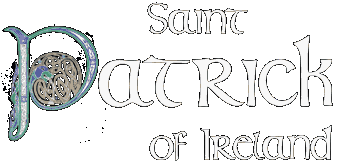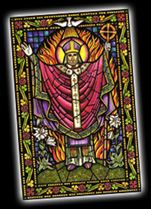 He was the son of a Roman official, Calpurnius, living probably in Wales. As a boy of sixteen, Patrick was captured by raiders and sold to an Irish chieftain, Milchu. He spent years in slavery, herding sheep on Slemish Mountain in Co. Antrim. He escaped following a dream in which a voice told him a ship would be waiting to take him to his own country. After a journey of 200 miles he found the ship, and was eventually able to return to his family. One night, in a dream, he heard voices calling him back to Ireland. It is thought that he studied under Saint Germanus at Auxerre, France, and that his mission to Ireland was approved due to the early death of Saint Palladius, who had been sent as a bishop to the Before long Patrick made his way to the Hill of Tara, Co. Meath, seat of the high king of Ireland. Arriving on the eve of Easter, he lit a paschal fire on the nearby Hill of Slane. At this time of year, it was pagan practice to put out all fires before a new one was lit at Tara. When the druids at Tara saw the light from Slane, they warned King Laoghaire that he must extinguish it or it would burn forever. Patrick was summoned to Tara, and on the way he and his followers chanted the hymn known as "The Lorica" or "Saint Patrick's Breastplate". Although Laoghaire remained a pagan, he was so impressed by the saint that he gave him permission to make converts throughout his realm. Muirchu's Life of Patrick, written two centuries later, describes a contest of magic in which Laoghaire's druids had to concede victory to the saint.Patrick travelled widely in Ireland, making converts and establishing new churches, though he eventually made his headquarters at Armagh. On one occasion he spent the forty days of Lent on a mountain in Co. Mayo which is now called Croagh Patrick. He was harassed by demons in the form of blackbirds, clustered so densely that the sky was black, but he continued to pray, and rang his bell to disperse the assailants. An angel then appeared to tell the saint that all his petitions for the Irish people would be granted, and that they would retain their Christian faith until Judgement Day. There are many legends about Patrick, not least that he banished snakes from Ireland and that he adopted the shamrock as a symbol of the Holy Trinity. Patrick's writings belong to the latter part of his life and confirm that he was less learned as a writer than he was persuasive as a speaker. Nonetheless, the Confession, a response to criticisms of his mission in Ireland, is a moving revelation of his vocation and of the divine guidance he received in dreams. Irish annals give the date of Patrick's death as 493, but an earlier date of 461 seems more likely. Tradition says he died at Saul and was buried at nearby Downpatrick.
Download the Adobe Acrobat Reader if you don't already have it to use the file. |
www.irelandseye.com
 Irish "believing in Christ" in 431. Consequently, 432 is the traditional date for Patrick's voyage to Ireland, which ended on the shores of Strangford Lough. He quickly made a convert of a local chief named Dichu, who gave him a barn at Saul, Co. Down, for his first church.
Irish "believing in Christ" in 431. Consequently, 432 is the traditional date for Patrick's voyage to Ireland, which ended on the shores of Strangford Lough. He quickly made a convert of a local chief named Dichu, who gave him a barn at Saul, Co. Down, for his first church.